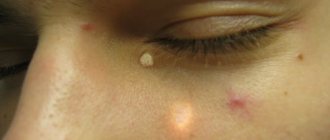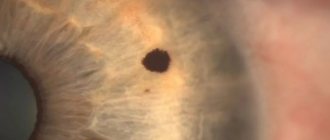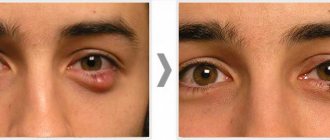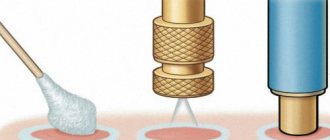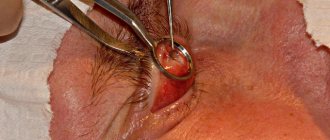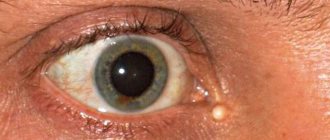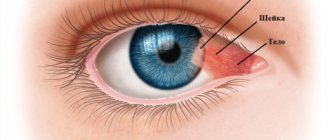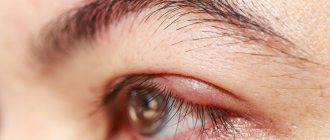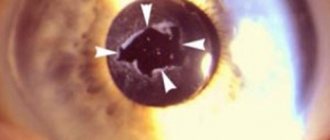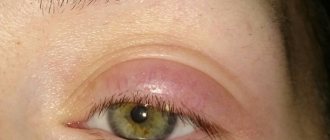Home > Laser surgery / Removal of tumors / Removal of moles > Laser removal of a mole on the eyelid
The appearance of moles on the eyelids causes physical and psychological discomfort, so their owners often turn to cosmetology clinics with a request to remove the tumor.
Almost every person has moles and they can be located on any part of the body. However, there are areas that are less likely than others to form benign nevi. These, in particular, include the eyelids: moles appear on them relatively rarely. But if a nevus has already formed, its presence causes great discomfort.
Consultation on the day of the procedure is free
Firstly, this is a cosmetic defect that is extremely difficult to hide from others. Secondly, if the nevus is large and located directly on the eyelash line, it can deform the eyelid and injure the surface of the eyeball. Thus, the need to remove a mole on the eyelid becomes obvious, and even the relatively high price of this procedure in Moscow does not stop those who want to get rid of the tumor.
Why should a mole on the eyelid be removed at a cosmetology center?
- The skin of the eyelids is very thin and delicate, so during manipulation it is very important to regulate the intensity of the effect in order to avoid the formation of too deep and extensive damage.
- The close proximity of the eyeball requires careful selection of the method for removing a mole on the eyelid. The procedure should be as non-invasive as possible, not accompanied by the formation of scars, and accompanied by a minimum rehabilitation period.
- The eyelid is literally dotted with many blood vessels, so the procedure for removing a mole may be accompanied by bleeding. To avoid this, you need to choose the right removal method and perform all manipulations carefully and accurately.
In order for all these requirements to be met, the removal of a mole on the eyelid should be entrusted to qualified doctors, and the procedure itself should take place in a specialized clinic.
The danger of growths on the eyelids
Growths on the upper or lower eyelid are associated with an increase in the rate of cell division. In this case, the disease can affect not only the eyelids, but also the conjunctiva, optic nerve, choroid, orbit, and lacrimal gland. This process can be benign, but sometimes malignant. In this case, growths on the eyelids can also be of a metastatic nature.
Benign growths on the eyelids grow very slowly and do not metastasize, while malignant growths grow quickly and often metastasize.
Treatment
The most effective methods for treating growths on the upper and lower eyelids are surgical and laser removal methods. They will allow you to completely remove the tumor and obtain a histological conclusion.
In some cases, cryotherapy is used - exposure to liquid nitrogen. The essence of the technique is to freeze the growth, which will fall off on its own in a few days.
A specialist determines which formations on the eyelids need to be removed. Some do not need to be deleted, just observing is enough.
If the growth is caused by the human papillomavirus, then a course of antiviral therapy is prescribed to prevent the appearance of new growths.
Celandine is popular among folk remedies. It is recommended to lubricate the wart with the juice of a freshly cut plant three times a day. You cannot use aggressive ingredients, you cannot remove tumors yourself. Do not expose bleeding or painful growths.
It is believed that homeopathy and treatment of growths on the skin of the eyelids with folk remedies do not bring any visible effect.
You will learn more about pathology from the video:
Symptoms of growths on the eyelids
The main symptom associated with the growth of a tumor on the eyelid is the appearance of nodules. They often change shape and color, begin to gradually increase in size, bleed, and sometimes itch. If the growth has spread to the conjunctiva, visual acuity may decrease and hyperemia may occur. When the neoplasm is localized intraocularly, the color of the iris changes, and it becomes impossible to move the eye due to pain. The eyelids themselves may swell.
When a growth develops on the eyelids, there is also a feeling of sand in the eyes, a sharp decrease in visual acuity, the appearance of pus, and lacrimation. If any of these symptoms bother you, you should see an ophthalmologist as soon as possible.
Papilloma on the eyelid
Symptoms: what papillomas look like on the eyelids
Externally, papillomas on the eyelids look like a small growth, the color of which does not differ from the color of healthy skin. The size of the neoplasm rarely exceeds 1-2 millimeters, although there are cases where the growth has reached a centimeter in diameter. The surface of the skin over the affected area is rough. The formation is painless, but if it is mechanically damaged, unpleasant sensations are possible.
The specificity of papillomas on the eyelids is that they can cause significant physical discomfort and even medical problems. Patients often complain of a feeling of “sand” or a foreign body in the eye, although the formation is located on the outer surface of the eyelid. Possible symptoms include watery eyes or dry eyes. Some patients develop conjunctivitis and blepharitis. Although these conditions do not pose a serious threat to health or vision, if papilloma appears on the eye, it is better to seek the help of a specialist as soon as possible.
How to get rid of papillomas?
Since papilloma is not just a skin growth and an aesthetic defect, but a manifestation of a chronic viral infection, solving the problem requires an integrated approach using various areas of treatment.
The patient is prescribed non-specific antiviral therapy with drugs that suppress the reproduction and activity of the virus. For these purposes, the doctor may prescribe Panavir, Acyclovir, oxolinic ointment and other antiviral agents.
The second direction of treatment is to increase the general and local resistance of the body to pathogens of infectious diseases. To strengthen the immune system, immunostimulants are prescribed. Echinacea has a general strengthening effect on the body. You can use medicinal herbs. Drugs that promote the production of interferon (Viferon) have a more specific effect.
Removal of papilloma on the eyelid is the most important condition for successful therapy. Why is it important to get rid of education? The growth is a focus of infection, and the virus is in active form. On the one hand, formations on the eyelid represent a cosmetic defect. On the other hand, it can lead to infection of family members. Finally, removing the source of infection contributes to the complete elimination of the pathogen from the host’s body.
Removal methods
How to remove papilloma on the eyelid? Because the skin on the eyelid is very thin, with the advent of modern surgical technologies, traditional surgical removal of papilloma is rarely used. In Moscow clinics, these formations are removed using microsurgical equipment - a laser, electrocoagulation or radio wave scalpel.
Laser papilloma removal is considered the most effective and safe. The procedure, which is performed using a carbon dioxide laser, has the following advantages:
- With the help of local anesthetics, removal can be done painlessly.
- The laser has stimulating properties and promotes rapid healing of the skin after surgery.
- Thanks to the coagulating properties of the laser, bleeding and damage to healthy skin areas are minimized.
- There is no risk of infection, since the laser cannot be a source of infection and has a detrimental effect on viral and bacterial flora. Thanks to these properties, the laser increases the effectiveness of antiviral therapy and helps eliminate infection.
- The rehabilitation period is short.
- There is no risk of scar or scar formation.
- There is no risk of relapse of the disease.
Removing the growth at home is a less effective (most often ineffective) tactic. Local use of traditional medicine is not justified; you should contact a specialist immediately when a formation appears.
Diagnosis of eyelid growths
All patients with symptoms of eyelid neoplasm should undergo a complete examination:
- Ophthalmoscopy with magnification, biomicroscopy;
- Visometry with determination of visual acuity;
- Computer perimetry;
- Tonography;
- Laser tomography using a retinotomograph.
Additionally, if necessary, MRI, CT, radiography, and laboratory examination are prescribed. An important study is a biopsy of the eyelid growth and a histological examination of a tissue sample.
If there are concomitant diseases, you may need to consult a therapist, oncologist, endocrinologist, or dermatologist.
Cost of laser mole removal
| Laser tumor removal | Prices, rub. |
| Laser removal of papillomas, single warts - Cat. I. difficulties | 1200 |
| Laser removal of papillomas, multiple warts - Cat. I. difficulties | 350 |
| Laser removal of moles, papillomas, warts - Cat. II. difficulties | 700 |
| Laser removal of moles, papillomas, warts - Cat. III. difficulties | 1500 |
| Laser removal of moles, papillomas, warts - IV category. difficulties | 3000 |
| Laser removal of moles, papillomas, warts - Cat. V. difficulties | 4500 |
| Laser removal of moles, papillomas, warts - Cat. VI. difficulties | 6100 |
| CO2 Laser callus removal (per unit) | 6100 |
| Removal of atheroma, lipoma, fibroma, xanthelasma with laser - Cat. I. difficulties | 6 900 |
| Removal of atheroma, basal cell carcinoma, lipoma, fibroma, xanthelasma with laser - Category II. difficulties | 9 400 |
| Removal of atheroma, basal cell carcinoma, lipoma, fibroma, xanthelasma with laser - Cat. III. difficulties | 16 900 |
| Removal of atheroma, basal cell carcinoma, lipoma, fibroma, xanthelasma with laser - IV category. difficulties | 22 400 |
| Removal of atheroma, basal cell carcinoma, lipoma, fibroma, xanthelasma with laser - Cat. V. difficulties | 33 400 |
Sign up for laser removal of a mole on the eyelid
- Full name
- Telephone
How to rid the eyelid of a mole?
To remove a tumor, different methods are used:
- Surgical. Under local anesthesia, the surgeon uses a small scalpel to excise the eyelid and separate the nevus tissue from healthy tissue. This operation is accompanied by suturing and significant discomfort during the rehabilitation period.
- Cryodestruction. This method is only suitable for cases where the mole is located away from the eyelash line. The neoplasm is treated with liquid nitrogen, under the influence of which its cells die. If the nevus is large, several treatments may be required, and after each of them, a crust will form on the skin of the eyelid, as if from a burn.
- Electrocoagulation. Treatment of neoplasm with electric current is also not suitable for all cases. The procedure requires local anesthesia and additional protection of the eyeball, as well as high precision of manipulation.
Laser removal of moles on the eyelid
The use of a laser can be called one of the most modern and safe ways to remove nevi on the eyelids. Its peculiarity is that the tumor is eliminated in the clinic with a laser beam with certain parameters. During treatment, the laser evaporates the cells of the mole layer by layer without affecting healthy tissue. Thanks to numerous settings, the doctor clearly controls the process and performs all actions with maximum precision.
Photos before and after the procedure
Need specialist help? Come to DECA
At the clinic you can consult with the best dermato-oncologist in Russia - Professor, Doctor of Medical Sciences Larisa Vladimirovna Chervonnaya. Our list of services also includes histological examination of tissues for oncology (mandatory when using a laser), which saves time for patients.
Removal of eyelid tumors - laser and surgical methods - has long been constantly practiced by our experienced specialists. Therefore, when you contact DECA, you will be able to solve the problem of the “presence” of a mole, wart, papilloma on the eyelids quickly and without pain. Sign up for a consultation right now by phone!
How tumors in the eyelid area are removed
Laser is considered the optimal method for removing benign tumors in all respects.
: fast, safe and bloodless. The laser acts selectively, only on pathological structures, therefore eliminating the risk of burns to the skin or organs of vision. After healing, no traces remain at the site of the mole.
DECA specialists prefer the laser method (if there are no contraindications). High-tech Italian equipment will allow you to achieve absolute precision in all manipulations and get excellent results.
In addition to the laser method, neoplasms on the eyelids can be removed:
- cryodestruction, when liquid nitrogen is used for cauterization;
- electrocoagulation, which means exposure to high-frequency currents;
- surgical excision if the tumor is large or malignant.
Some experts advise first trying to get rid of the tumor without hardware procedures - for example, with celandine tincture. We strongly DO NOT recommend trying this method.
Navigation
- How tumors in the eyelid area are removed
In such cases, the tumor must be removed.
What appears on the eyelids?
` In most cases, papillomas and warts (senile warts), that is, neoplasms of epithelial origin, form in the eyelid area. Also, lipomas, fibromas and benign nevi often arise here. In elderly patients, yellowish cholesterol plaques, or xanthelasmas, are observed, which usually indicate a disorder of lipid metabolism. As for malignant neoplasms, the most common in the eyelid area is basal cell carcinoma.
Any benign neoplasm carries a certain threat: under the influence of one or another factor, the process of malignancy can begin. Risk factors include trauma to neoplasm tissue, exposure to ultraviolet radiation, and self-medication.
It’s worth mentioning separately about self-medication. The use of traditional methods to eliminate a mole or papilloma on the eyelid is doubly dangerous: there is a high risk of a harmless mole degenerating into a malignant tumor and there is a risk of damaging the organs of vision (especially if aggressive compounds are applied to the mole to “cauterize”). Well, of course, a scar is guaranteed to remain.

